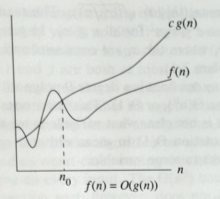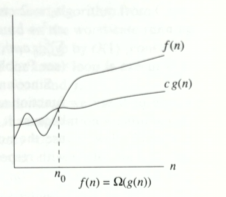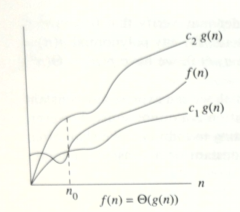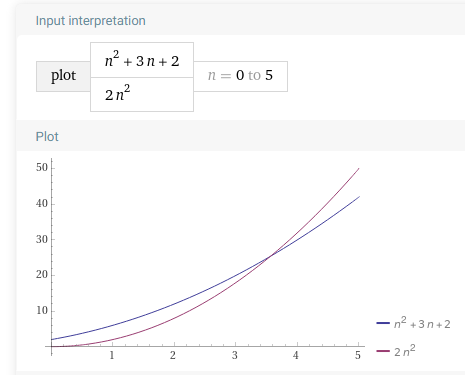Asymptotic Notation
- Since we are talking about timing algorithms, it is safe to limit all functions to be non-negative.
- To start things off, three definitions.
- $O(g(n)) = \{f(n) : \exists ~ c > 0, n_0 > 0 \ni 0 \le f(n) \le cg(n) ~ \forall ~ n \ge n_0\}$
-
 (Figure from CLR)
(Figure from CLR)
- $\Omega (g(n)) = \{f(n) : \exists ~ c > 0, n_0 > 0 \ni 0 \le cg(n) \le f(n) ~ \forall ~ n \ge n_0\}$
-
 (Figure from CLR)
(Figure from CLR)
- $\Theta (g(n)) = \{f(n) : \exists ~ c_1 > 0, c_2 > 0 , n_0 > 0 \ni 0 \le c_1g(n) \le f(n) \le c_2g(n) ~ \forall ~ n \ge n_0\}$
-
 (Figure from CLR)
(Figure from CLR)
- $n_0, c, c_1$ and $c_2$ are all constants.
- Or
- $O$ is bound from above, a function is no worse (larger) than this.
- $\Omega$ is bound from below, a function is no better (smaller) than this.
- $\Theta$ is bound from above and below, these functions are asymptotically the same.
- Note, these are sets of functions.
- It is right to say that $n^2+3n+2 \in O(n^2) $
- It is common to say that $n^2+3n+2 = O(n^2) $
- It is common to say that $n^2+3n+2 $ is $ O(n^2) $
- But is $n^2+3n+2 \in O(n^2) $?
- To show this, we would need to find $c>0, n_0 > 0$ such that $n^2 + 3n + 2 \le cn^2$ when $n > n_0$.
- $$ \begin{eqnarray}
n^2 + 3n + 2 \le cn^2 \\
1 + \frac{3n+2}{n^2} \le c \\
\end{eqnarray}$$
- Looking at $\frac{3n+2}{n^2}$, it is clear that for $n > 3$, this term is less than 1, so select $c = 2$ and $n_0 = 4$.
-

- By the way, this is not really an exercise you do.
- But what are we doing here.
- Remember we are looking at primitive operations.
- In general, we mean operations that can be performed by a CPU in a single cycle
- But remember from architecture, different CPUs have different instruction sets.
- Consider
- This program: code.cpp
- In mips.s mips assembly code
- $m(n) = 25n+10$
- In intel.s mips assembly code
- $i(n) = 11n + 6$
- Are these two really different?
- Again in architecture you considered things like CPI, Instructions, Clock Cycle length.
- Here we just say $m(n) \in O(n^2) $ and $i(n) \in O(n^2)$
- So the two are really equivalent.
- in some sense we are saying
- Ignore the startup costs
- these are the constants (+10 and +6).
- Ignore the difference in instruction count in the loop.
- These are the coefficients (25 and 11)
- Eventually for $n>10, i(n) \le 26n$ and $m(n) \le 26n$
- Just a final note.
- O(n) is an upper bound.
- $n^2 \in O(n^2)$,
- $n^2 \in O(n^3)$,
- $n^2 \in O(n^{1000})$,
- The first is a tight upper bound.
- We like tight upper bounds.
- And lower bounds, and total bounds too.
 (Figure from CLR)
(Figure from CLR)
 (Figure from CLR)
(Figure from CLR)
 (Figure from CLR)
(Figure from CLR)
